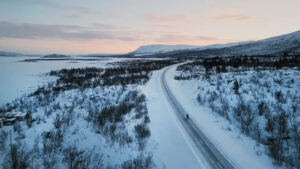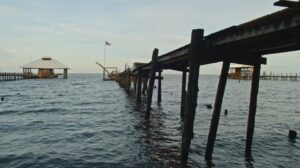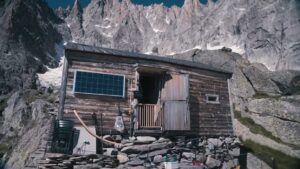“I’d been trying to find a way of living that could make me happy.”
By the time Pierre Auzias washed up in the village of Uummannaq, 700km above the Arctic circle, he’d already led a rich life as an official maritime painter to the Royal Danish Navy. But he felt that something was still missing.
When “the love of [his] life,” Annie, took a job as a medical professional in Uummannaq, Pierre became intrigued by the culture of the tiny Greenland community.
Soon enough, Pierre was speaking the language, fishing, and raising and running dogs. But when Annie retired and made the decision to move back to France in 2016, it left Pierre in a quandary. The couple was living in the village because of Annie’s medical work, and with her gone, Pierre had no legal right to be in the country.

Pierre Auzias’ love for his dogs is a running theme in ‘A Greenlander.’ Photo: Screenshot
He filed for a visa, crossed his fingers, and settled in to wait, hoping against hope that the gears of bureaucracy would turn slowly in his favor.
A Greenlander is the story of that wait. The 35-minute film deftly brings the viewer into Pierre’s world as he goes about his daily life: painting, teaching art therapy classes, fishing, and raising his dogs. Along the way, he grapples with what it will mean to leave a community he’s grown to love. In particular, he frets about the fate of his dogs.
“I cannot imagine that I will be able to live without them. It will be very, very difficult,” Pierre says.
Wrestling with home and belonging
Filmmaker Nicholas Jones deftly avoids the tired white savior narrative. Pierre’s contributions as an art teacher and community member are noted but not lionized. As the film progresses, it becomes apparent that Pierre himself makes it possible to avoid the trope. He views his adopted community with an artist’s eyes, rather than a tourist’s or a scientist’s.

Filmmaker Nicholas Jones directed, shot, and edited ‘A Greenlander.’ Photo: screenshot
It’s no spoiler to say that Pierre’s visa application is denied. A Greenlander is a film about what it means to be from a place — to be of a place. To face leaving is an integral part of that journey.
At a going-away dinner a few days before Pierre leaves, an Uummannaq community member gives him perhaps the best parting gift he could receive: a touching monologue about his value to the community.
“It would be totally wrong if there were no Pierre in Uummannaq,” the woman says. “You use our nature and our tools. We are proud of it. [Some] people coming from outside, they are just like decoration in town, right? You are more than a decoration. You use our own things. Try to think about it. It’s a totally different thing. You simply consider yourself like a little Uummannamioq.”

What does it mean to be of a place? Photo: screenshot
It’s a powerful moment and one that resonates as A Greenlander draws to a close. The film’s final shots are of Pierre looking out over the water, surrounded by his beloved dogs, reflecting on what his time in the village has taught him.
In a community caught somewhere between the traditional and the modern, it’s clear Pierre finally found “a way of living” that made him happy. In chronicling Pierre’s journey, A Greenlander serves as a template for anyone looking for the same thing. And while there’s loss, there’s also hope, suggested by the return of Pierre’s smile as he looks out over Uummannaq for the last time.
Anything found once can be found again.






